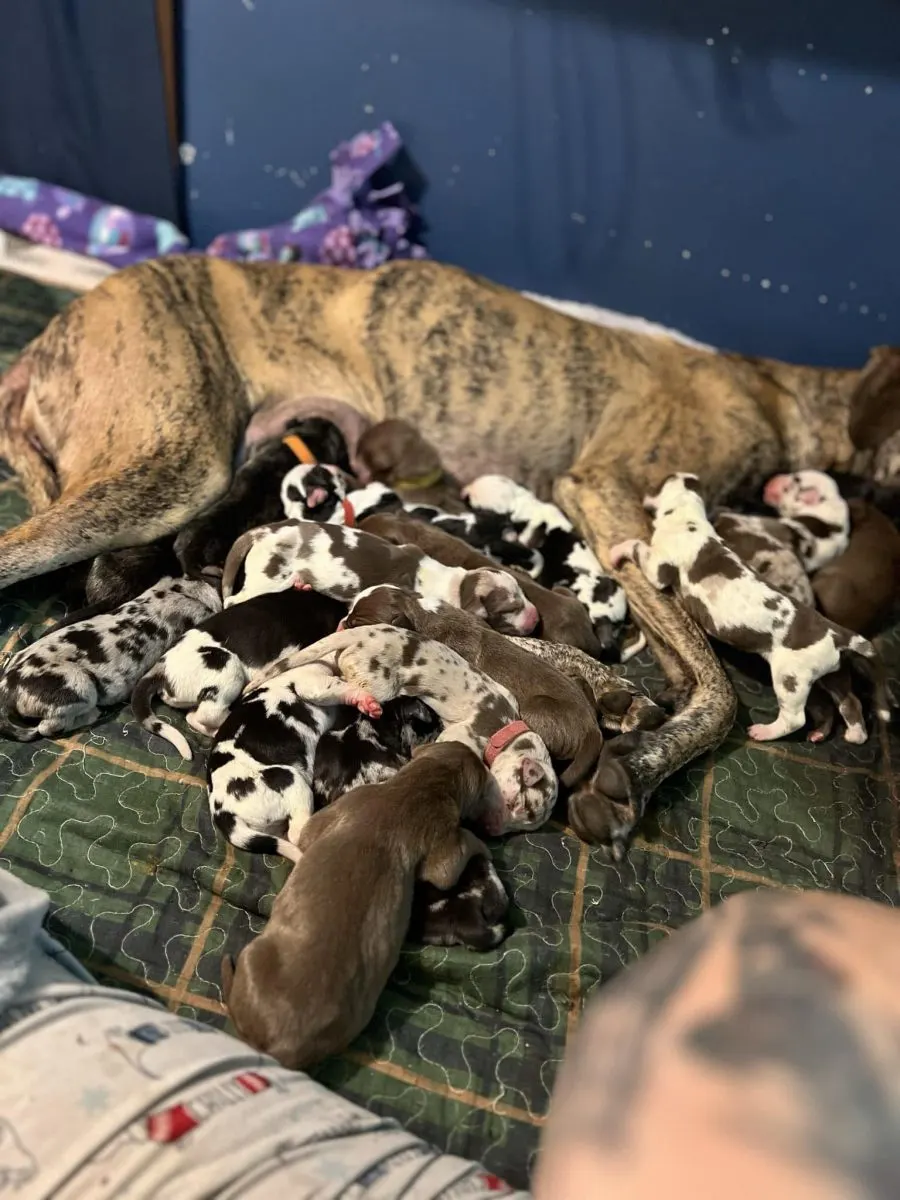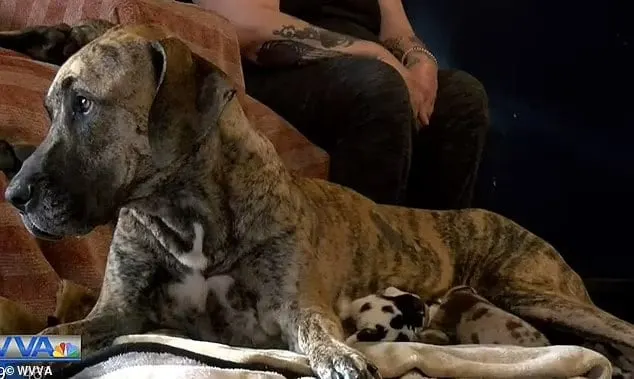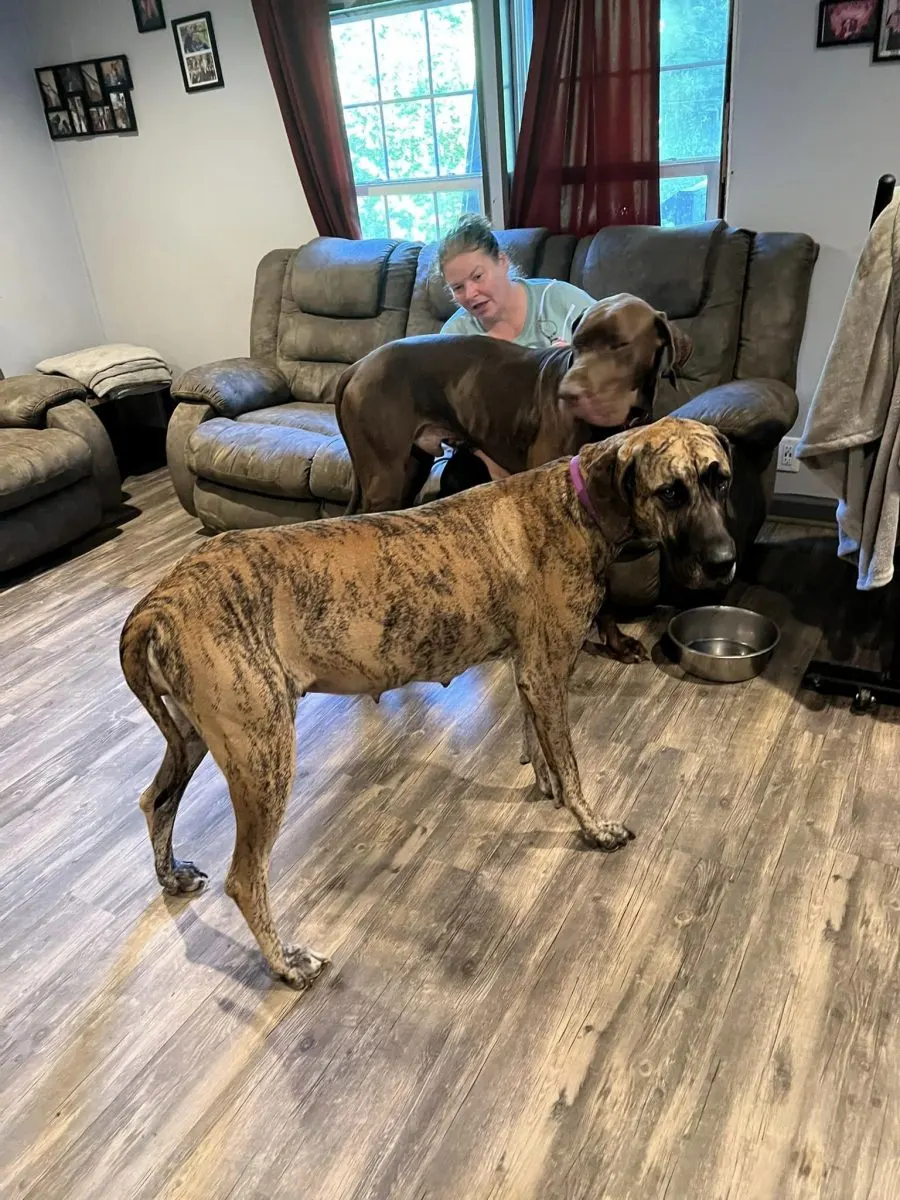Giving birth to a litter is always overwhelming, but a pretty special time to female dog owners! If you have witnessed one, then you know that there are very few things in the canine world that could even remotely compare to the beauty of a doggo mom-puppy relationship.
In March of this year, Tanya Dubbs, from Pocahontas, Virginia, was about to witness one herself, but little did she know that her mama dog, Namine, would end up making the headlines of the U.S. most popular news!
This two-year-old Great Dane ended up giving birth to an unbelievable 21 puppies over the course of 27 hours!
One Of The Largest Litters Ever

Tanya and her family were quite shocked when they realized Namine’s litter was exceeding all their expectations. Being one of the tallest dog breeds in the world, Tanya naturally expected a larger litter – around 13 to 14 pups maximum.
Even when they got up to number 16, she and her family didn’t believe that the total number would exceed two dozen, but after a long, 27-hour labour – it happened!

Unfortunately, two of the puppies passed away just a few hours after birth, leaving Namine with 19 of them.
Almost all of them weighed over a pound when they were first born, except two that were slightly under – one 94, and the other one, 98 ounces.
As there’s now a slight logistical problem with momma’s milk, Tanya makes sure all puppies are fed properly, and if some of them don’t get enough food the natural way, she supplies them with a bottle.

While this is a pretty amazing number and probably one of the largest litters in the world, the Neapolitan Mastiff, Tia, is still holding the world record, with 24 puppies born in one litter.
Last Year, She Survived A Life-Threatening Accident
This beautiful doggo mom has a unique story behind her. Last year, she ran away from the house overnight with her sibling, Malificent, and got hit by a truck, leaving her with her back and her eye injured.

“My sweet Namine and Malificent escaped this evening. Malificent came back… Namine has not. I was told that she got hit by a car,” Tanya posted that night.
Luckily, she got patched up sixteen hours later and suffered no life-threatening repercussions after all.
Living The Pawfect Little Life With Her Family

Tanya’s plan is to sell all the puppies since they’re all weaned by now. She’s planning to donate some of the money that she receives from selling them to Tazewell County Animal Shelter, in Bluefield, Virginia.
Luckily, Namine already has a big family of hoomans and doggo siblings so she won’t feel alone after all. She’s a big doggo girl who enjoys spending days with her loved ones, and even though her puppies won’t be there anymore, she’ll always receive lots of love!

But, receiving love isn’t exactly all she has in mind, as she’s quite a giver, too! Namine enjoys showing love to her hoomans, as well as taking care of the little ones! Just like all Great Danes, she’s a Great nanny to children, and she absolutely adores taking care of them!
If you’ve ever found yourself wondering why your furry friend showers you with endless licks, you’re not alone. Dog owners often experience the puzzling phenomenon of excessive licking from their beloved pets. It’s a behavior that can range from endearing to downright perplexing, leaving you questioning the reasons behind it.
You may have noticed your dog’s persistent licking during moments of affection, playtime, or even when you’re simply relaxing together. While it’s a common behavior among our canine companions, the motivations behind this slobbery display can vary and sometimes leave you scratching your head. Let’s take a closer look at the intriguing world of why dogs engage in this seemingly affectionate yet sometimes puzzling behavior.
Understanding Canine Behavior: Why Licking Occurs
The Emotional Connection
Dogs licking you excessively isn’t just about their slobbery nature; it’s a form of emotional connection. It’s their way of showing affection, love, and respect towards you. When your furry friend licks you, it releases endorphins, making them feel happier and more secure. Remember, in the world of dogs, licking is a sign of bonding.
Communication and Sensory Exploration
Licking also serves as a means of communication for dogs. It’s a way for them to express their needs, wants, and feelings. By licking you, they might be trying to tell you they’re hungry, anxious, or simply seeking attention. Additionally, dogs explore the world through their sense of taste, and licking allows them to gather information about their surroundings.
Remember, your dog’s excessive licking behavior is often a manifestation of their love and need for communication. Understanding these aspects of canine behavior can help strengthen your bond with your furry companion.
Health-Related Reasons for Excessive Licking
Stress, Anxiety, and Compulsive Disorders
Excessive licking in dogs can sometimes indicate underlying stress, anxiety, or compulsive disorders. When your dog feels overwhelmed, anxious, or stressed, they may resort to licking as a coping mechanism. This repetitive behavior can help soothe their nerves temporarily but may become excessive if the underlying issues persist. If your dog is licking you excessively, it might be a sign that they are struggling with emotional challenges that need attention.
Medical Issues and Disease
In some cases, excessive licking can be a manifestation of medical problems or underlying diseases in dogs. It’s essential to rule out any physiological issues that could be causing your dog to lick excessively. Skin allergies, infections, gastrointestinal problems, or even neurological conditions can trigger excessive licking behavior in dogs. If you notice persistent and abnormal licking patterns in your dog, it’s advisable to consult a veterinarian to rule out any potential health concerns.
How Much Licking Is Too Much?
Identifying Normal Vs. Excessive Licking Behavior
Normal dog licking is a common way for them to show affection and communicate with you. It’s a natural behavior observed in most dogs. They may lick your face, hands, or any exposed skin as a sign of bonding and comfort. However, when this licking becomes excessive and persistent, causing distress to you or your dog, it might indicate an underlying issue that needs attention.
Excessive licking can vary from dog to dog based on their breed, personality, and habits. If your dog’s licking behavior seems constant, compulsive, or interferes with regular activities, it could be a cause for concern. Watch out for signs like red or irritated skin, hair loss, or changes in your dog’s overall demeanor alongside the excessive licking. These could be indicators of an underlying problem that requires intervention.
When to Seek Veterinary Advice
If you notice a sudden increase in your dog’s licking behavior or if it becomes obsessive and disruptive, it’s time to consult a veterinarian. Excessive licking can be a symptom of various health issues such as skin allergies, infections, pain, or even psychological distress like anxiety or compulsive disorders.
When your dog’s licking goes beyond normal grooming habits and starts affecting their well-being, it’s crucial to seek professional help. A veterinarian can conduct a thorough examination to rule out any underlying medical conditions causing the excessive licking. Remember, early detection and intervention can help address the root cause and ensure the well-being of your furry companion.
Dealing with Excessive Licking
Training and Behavioral Modifications
If your dog is licking you excessively, it’s essential to address this behavior through training and behavioral modifications. Start by redirecting their focus when they begin to lick excessively. You can gently command them to “sit” or “stay” to distract them from licking. Consistency is key; praise and reward your dog when they follow your commands and stop licking.
Providing Alternatives and Enrichment
To curb excessive licking, provide your dog with suitable alternatives and enrichment activities. Offer them interactive toys or puzzle feeders to keep them engaged and mentally stimulated. Chew toys are also a great way to redirect their licking behavior onto a more appropriate item. Ensuring they get enough physical exercise can also help reduce stress and anxiety, potentially lessening their urge to lick excessively.
Professional Help: When to Consult a Behaviorist
If your dog’s excessive licking persists despite your efforts, it may be time to seek professional help from a behaviorist. A behaviorist can assess your dog’s behavior more comprehensively and provide tailored strategies to address the issue. They can also help rule out any underlying medical conditions causing the excessive licking. Remember, early intervention and seeking expert guidance can make a significant difference in managing your dog’s licking behavior.
The Role of Diet and Exercise
Nutritional Deficiencies and Food Allergies
When your dog licks you excessively, it might be signaling underlying nutritional deficiencies or food allergies. Pay attention to your dog’s diet, as certain deficiencies can lead to abnormal behaviors like excessive licking. Ensure your furry friend is getting a balanced diet with all the necessary nutrients to support their overall health and well-being. Consider consulting with a veterinarian to assess if your dog’s diet is contributing to their excessive licking habits.
The Impact of Exercise on Behavioral Health
Regular exercise plays a significant role in your dog’s behavioral health, including their licking tendencies. Insufficient physical activity can lead to stress and anxiety in dogs, manifesting in behaviors like excessive licking. Make sure your dog gets enough exercise based on their breed and energy levels. Engaging in physical activities not only helps in maintaining your dog’s overall health but also contributes to reducing stress and promoting positive behaviors. Prioritize regular playtime and walks to keep your dog physically and mentally stimulated, which could help decrease their excessive licking.
Conclusion
So, there you have it! Understanding why your dog licks you excessively is the first step in addressing this behavior. From showing affection to potential health issues, there are various reasons behind your furry friend’s constant licking. By implementing training techniques, providing stimulating toys, and ensuring a balanced diet, you can help curb this behavior. Remember, exercise plays a crucial role in your dog’s overall well-being, so make sure to keep them active. If excessive licking persists, seeking help from a behaviorist is a smart move. With the right approach and guidance, you can effectively manage your dog’s licking habits and strengthen your bond even more.
Frequently Asked Questions
Why do dogs lick their owners?
Dogs lick their owners to show affection, bond with them, and sometimes as a response to stress or anxiety.
What are signs of excessive licking in dogs?
Signs of excessive licking in dogs include red or irritated skin, hair loss, and a constant need to lick objects or people.
How can I address excessive licking in my dog?
You can address excessive licking in your dog through training, providing interactive toys, behavioral modifications, and ensuring a balanced diet.
Can diet and exercise impact a dog’s licking behavior?
Yes, diet and exercise play a crucial role in a dog’s licking behavior. Nutritional deficiencies and food allergies can contribute to excessive licking, while regular exercise can help reduce stress levels and promote positive behaviors.
When should I seek professional help for my dog’s licking behavior?
If excessive licking persists despite interventions, consulting a veterinarian or a behaviorist is recommended. Professional help can provide tailored strategies to manage the behavior effectively.
[no_toc]

Hey there, I’m Janet Brooks, a dog-loving student from California. I’m all about helping pups in need, especially those without homes. Me and my awesome friends work together to give shelter and love to stray dogs. Oh, and I also write blogs about dogs to share helpful info.